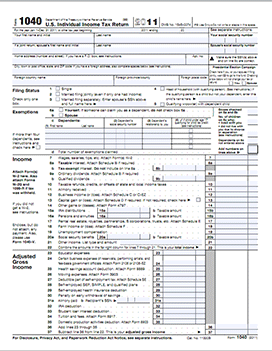The Form 1040, U.S. Individual Income Tax Return, is the starting form for personal (individual) federal income tax returns filed with the IRS. The first Form 1040 was published for use for the tax years 1913, 1914, and 1915. Beginning with the tax year 1916, Form 1040 was converted to an annual form (i.e., updated each tax year with the new year printed on the form).[4] The IRS used to mail tax booklets (Form 1040, instructions, and most common attachments) to all households prior to 2009.
Income tax returns for individual calendar year taxpayers are due by April 15 of the next year. Should April 15 fall on a Saturday, Sunday, or a legal holiday in Washington D.C. or in the state to which the return is required to be filed, the returns are due on the next business day. For example, in 2011, April 16 is a legal holiday, Emancipation Day, in Washington D.C. April 16, 2011, is a Saturday, so the holiday is observed on Friday, April 15, 2011. Because Friday, April 15, 2011 is a legal holiday in Washington D.C., Form 1040 income tax returns filed on Monday, April 18, 2011, will be treated as timely filed on Friday, April 15, 2011.
Form 1040 consists of two full pages not counting attachments. The first page collects information about the taxpayer(s), dependents, income items, and adjustments to income. The second page calculates the allowable deductions and credits, tax due given the income figure, and applies funds already withheld from wages or estimated payments made towards the tax liability. At the top of the first page is thePresidential election campaign fund checkoff, which allows you to designate that the federal government give $3 of the tax it receives to the Presidential election campaign fund.
Form 1040 has 11 attachments, called “schedules”, which may need to be filed depending on the taxpayer. For 2009 and 2010 there is an addition form, Schedule M, due to the “Making Work Pay” provision of the American Recovery and Reinvestment Act of 2009 (“the stimulus”):
- Schedule A itemizes allowable deductions against income; instead of filling out Schedule A, taxpayers may choose to take a standard deduction of between $5,700 and $15,800 (for tax year 2010), depending on age, filing status, and whether the taxpayer and/or spouse is blind.
- Schedule B enumerates interest and/or dividend income, and is required if either interest or dividends received during the tax year exceed $1,500 from all sources or if the filer had certain foreign accounts.
- Schedule C lists income and expenses related to self-employment, and is used by sole proprietors.
- Schedule D is used to compute capital gains and losses incurred during the tax year.
- Schedule E is used to report income and expenses arising from the rental of real property, royalties, or from pass-through entities (like trusts, estates, partnerships, or S corporations).
- Schedule EIC is used to document a taxpayer’s eligibility for the Earned Income Credit.
- Schedule F is used to report income and expenses related to farming.
- Schedule H is used to report taxes owed due to the employment of household help.
- Schedule J is used when averaging farm income over a period of three years.
- Schedule L is used to figure an increased standard deduction in certain cases.
- Schedule M (2009 and 2010) is used to claim the up to $400 Making Work Pay tax credit (6.2% earned income credit, up to $400).[5]
- Schedule R is used to calculate the Credit for the Elderly or the Disabled.
- Schedule SE is used to calculate the self-employment tax owed on income from self-employment (such as on a Schedule C or Schedule F, or in a partnership).
In most situations, other Internal Revenue Service or Social Security Administration forms such as Form W-2 must be attached to the Form 1040, in addition to the Form 1040 schedules. There are over 100 other, specialized forms that may need to be completed along with Schedules and the Form 1040.
Download the 1040 PDF By Clicking the image below.

